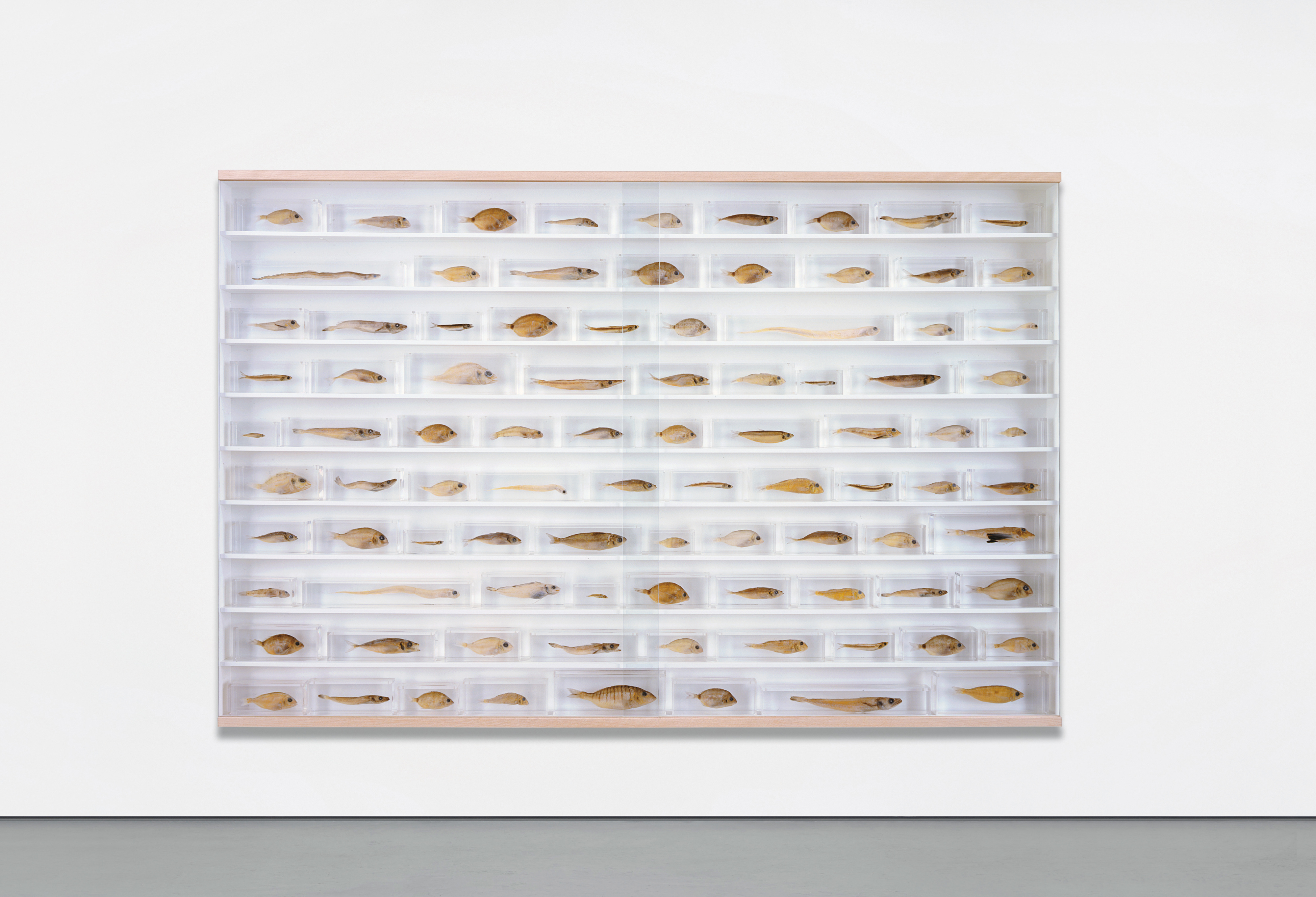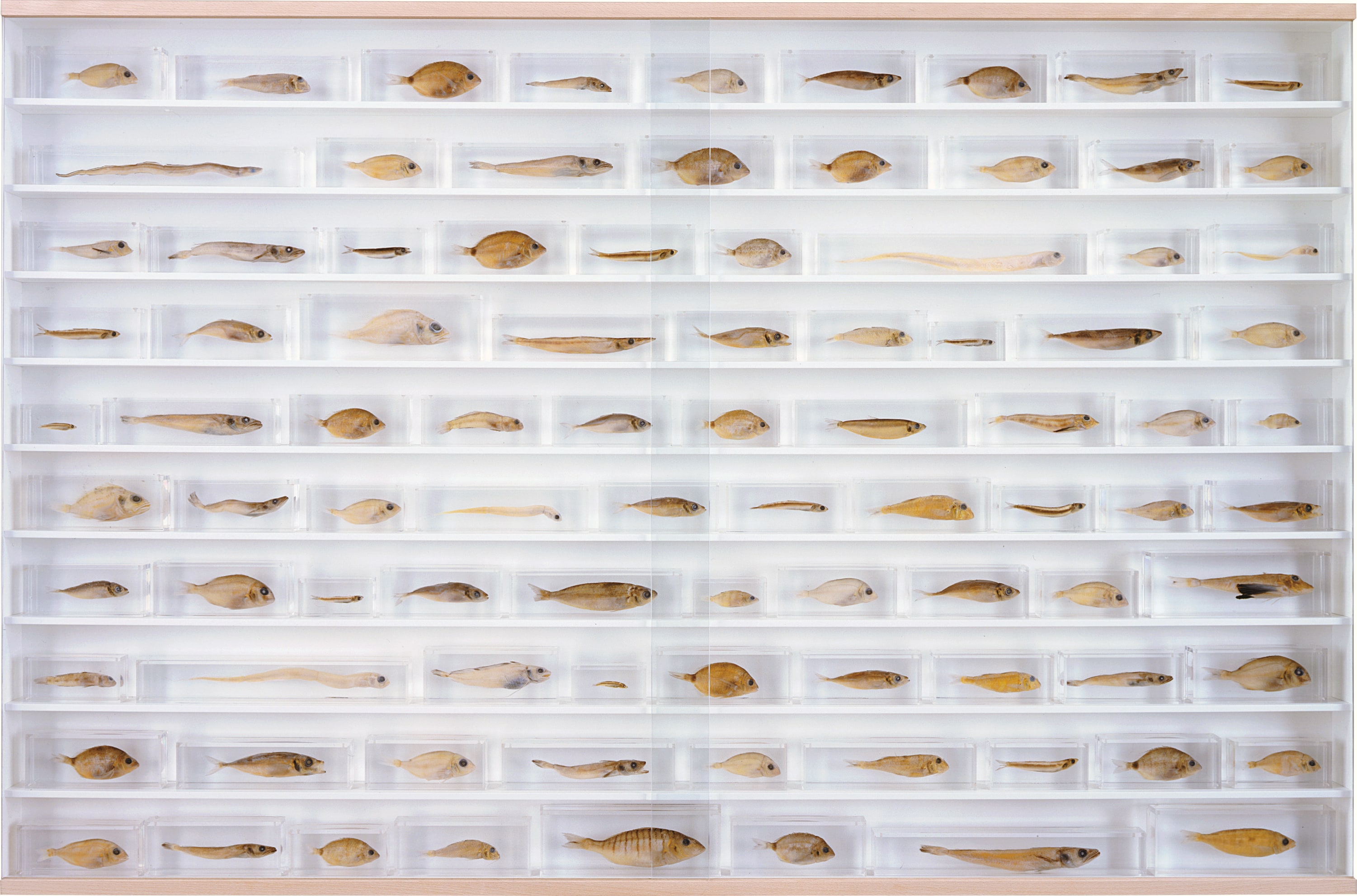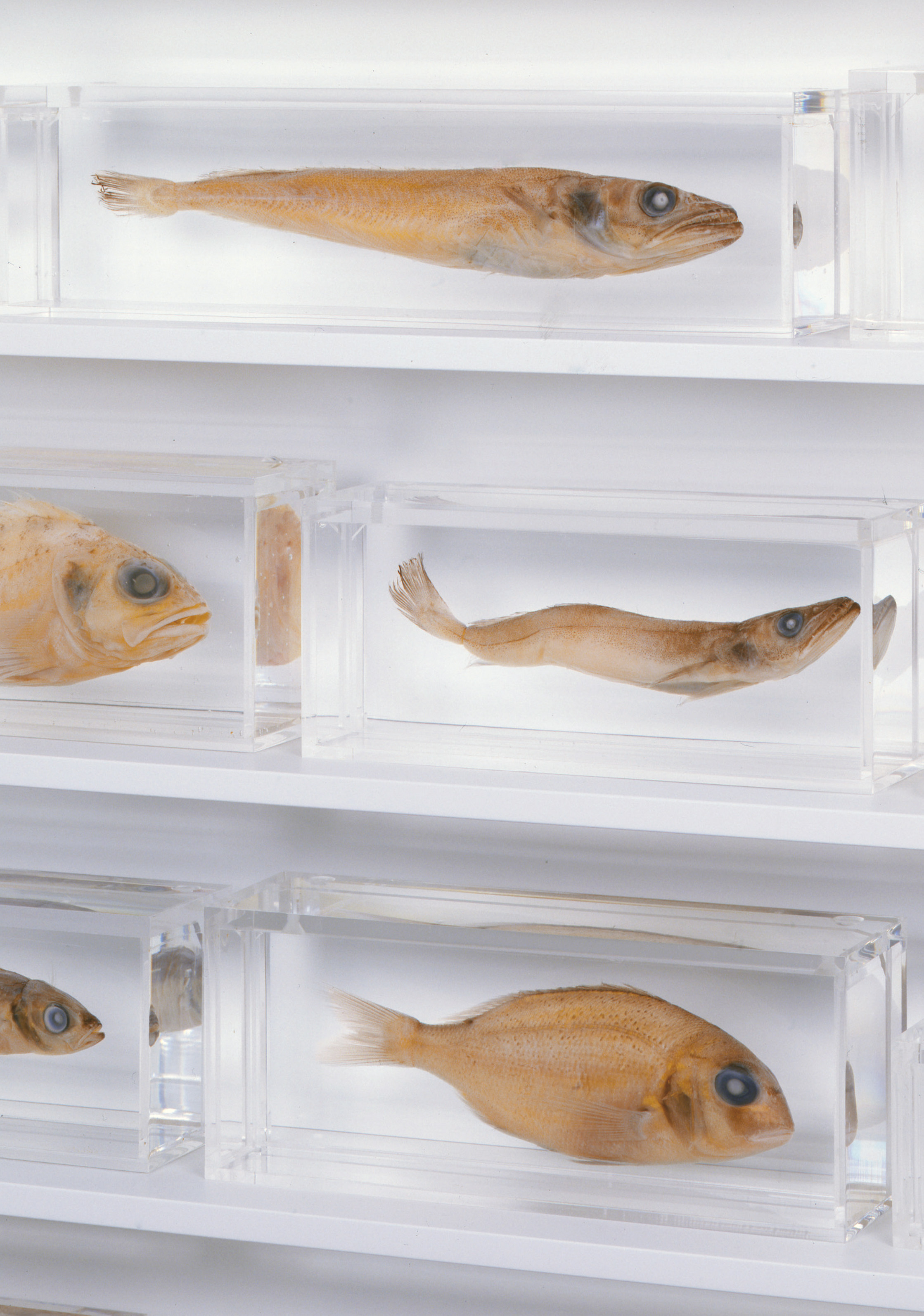





48
Damien Hirst
Without You
Full-Cataloguing
A member of the Young British Artists, Hirst garnered critical acclaim by creating artworks that shocked and appalled, possessing a conceptual depth in both profound and prankish ways. Without You is an elegant and daring example of Hirst’s 'nature mortes'. Using the nineteenth century mechanism of the display cabinet, Hirst presents the viewer with multiple varieties of fish which are fixed into Perspex boxes filled with formaldehyde, forming a perpetually frozen scene. The individually encased fish appear to act out a static ballet in an absurd movement towards nowhere. As Hirst commented: ‘They all face the same way yet they can’t make contact the way they do in the sea…in life we’re separated by flesh and bones and you can’t really move beyond that’ (Damien Hirst, quoted in Gordon Burn, ‘Is Mr. Death In?’, I Want to Spend the Rest of My Life Everywhere, with Everyone, One to One, Always, Forever, Now., London, 2006, p. 9). With each fish individually arranged, the overall effect is one of scientific ordering, aesthetically referring to the Victorian inclination for visual displays, created to reflect man’s control over nature. Challenging the idea of mankind’s omnipotence, Hirst also calls into question our awareness and convictions surrounding the boundaries between life and death, made even more powerful by the inclusion of real fish. The visceral realism of Without You is unavoidable; Hirst presents a new form of realism that is no longer illusionistic but corporeal.
In the present work, Hirst’s use of formaldehyde not only preserves the bodies of the fish, purveying the illusion of life, but preserves Hirst’s artistic concept which forces us to confront mortality and the violence of existence head on. As Hirst states ‘The Fish Pieces came first because you have to take them out of their element (the sea) and put them into formaldehyde. It preserves them in a very similar state to their natural one, only they’re dead’ (Damien Hirst, quoted in Gordon Burn, I Want to Spend the Rest of My Life Everywhere, with Everyone, One to One, Always, Forever, Now., London, 2006, p. 297). This combination of simplicity and metaphor attest to Jeff Koons’s sculptural works such as Koons’s Three Ball 50/50 Tank (Two Dr. J. Silver Series, One Wilson Supershot) which comprises basketballs floating in water as well as New Shelton Wet/Dry Doubledecker, part of a series of sculptures comprised of wall-mounted vacuum cleaners displayed in Plexiglas cases. These works all repurpose ‘ordinary things’, whether objects, or in Hirst’s case, fish, and explore the ways our fantasies, fears and desires are transferred on to them.
Hirst’s mode of presentation is of equal importance as the subject within. Indeed, for Hirst tanks, vitrines and cabinets act as display and framing devices but should also be considered as an object of formal, aesthetic consideration. As evident in the work of Joseph Cornell, presentation and arrangement lies at the core of Without You’s visual impact. In the same way that Cornell and Kurt Schwitter’s would amass and collect detritus and ‘merz’, to present the viewer with the discarded echoes of objects no longer needed, so Hirst recalls the bodies of creatures no longer living, their bodies lifeless. The poignancy of Cornell’s Victorian thrift and Schwitters’ littered papers and wrappers lies in their abandoned nature, like cultural footprints, whereas Hirst’s moribund fish highlight life through their overt stillness, devoid of vitality. Presenting this in a museum-like cabinet, Hirst utilises the clear- cut forms developed in Minimal art but recharges it with very different content. In Without You the series of Perspex boxes containing the fish in formaldehyde recall Donald Judd’s formal experimentations with geometry and minimalism to play with the effects of light and space to create evocative reactions. However, whilst Judd’s structures are serene in content, volume and space, the interiors of Hirst’s modern cabinet of curiosities are more disturbing and puzzling.
Prompting psychological reactions and feelings of fear, loneliness and death, the present work forces us to think of our mortal journey towards the great unknown. Despite evoking frightening and negative human emotions, Hirst’s Without You is not wholly melancholic. As Hirst states: ‘I think I’ve got an obsession with death, but I think it’s like a celebration of life rather than something morbid. You can’t have one without the other’ (Damien Hirst, quoted in Damien Hirst, Gordon Burn, On the Way to Work, London, 2001, p. 21).
Damien Hirst
British | 1965There is no other contemporary artist as maverick to the art market as Damien Hirst. Foremost among the Young British Artists (YBAs), a group of provocative artists who graduated from Goldsmiths, University of London in the late 1980s, Hirst ascended to stardom by making objects that shocked and appalled, and that possessed conceptual depth in both profound and prankish ways.
Regarded as Britain's most notorious living artist, Hirst has studded human skulls in diamonds and submerged sharks, sheep and other dead animals in custom vitrines of formaldehyde. In tandem with Cheyenne Westphal, former Chairman of Phillips, Hirst controversially staged an entire exhibition directly for auction with 2008's "Beautiful Inside My Head Forever," which collectively totalled £111 million ($198 million).
Hirst remains genre-defying and creates everything from sculpture, prints, works on paper and paintings to installation and objects. Another of his most celebrated series, the 'Pill Cabinets' present rows of intricate pills, cast individually in metal, plaster and resin, in sterilized glass and steel containers; Phillips New York showed the largest of these pieces ever exhibited in the United States, The Void, 2000, in May 2017.